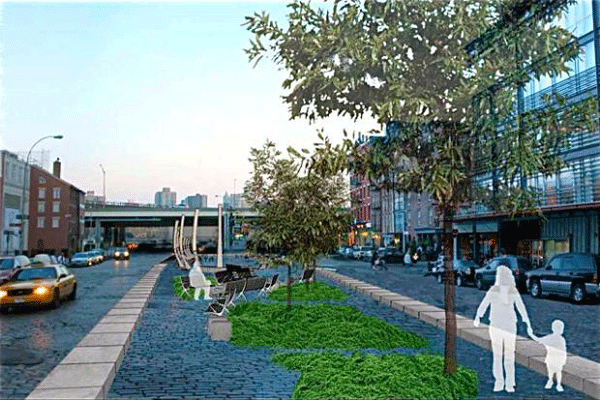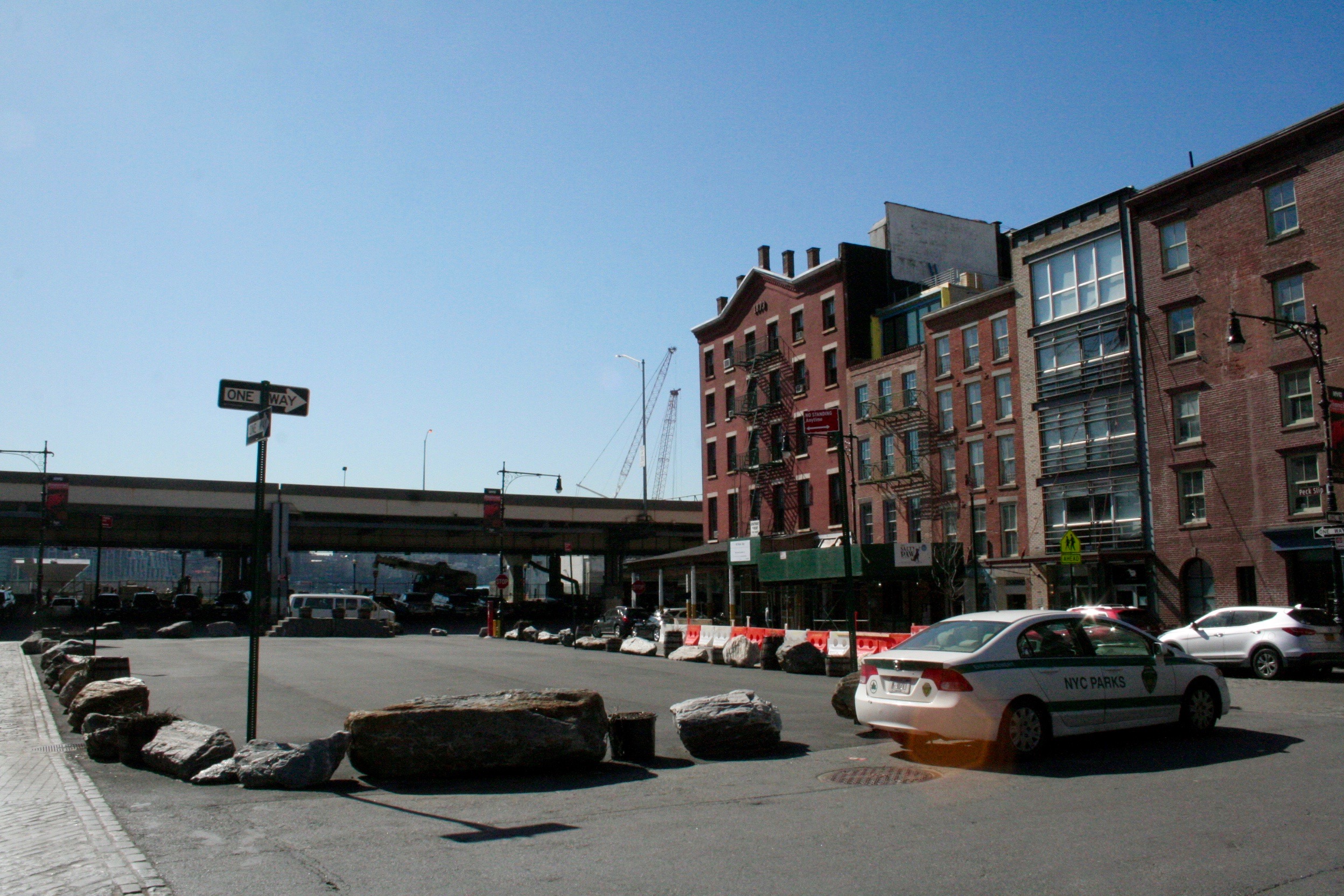
BY YANNIC RACK |
Green space is usually a welcome addition in any city community, but residents in the Seaport historic district are hoping a Parks Department plan to plant on a plaza in their neighborhood will wilt and die — so they can preserve the space as a European-style piazza instead.
Locals are rallying to make sure Peck Slip Plaza, which the city wants to rebuild as a green strip studded with large sculptures evoking the ribs of a burned-out ship, remains empty as a much-needed flexible open space in the historic district.
“We’re trying to push for an open plan, so the neighborhood can use this space, which is so unique,” said Jason Friedman, who lives on nearby Beekman St. and sends one of his kids to The Peck Slip School right next to the plaza.

Seaport residents would rather keep the blacktop plaza as is, offering an open, flexible-use space.
Community Board 1 passed a resolution at its full board meeting last month, asking Parks and the Lower Manhattan Development Corp., the city-state agency that awarded the $4 million for the project, to work with the community to find “a more historically appropriate design” that is “resilient, low maintenance and flexible.”
“We’re not proposing something that will cost more money, to the contrary,” said Friedman, an architect and CB1 member who drafted the resolution. “We should take that money and use it somewhere else in the neighborhood, for parks that need maintenance programs. They built five parks and playgrounds in the past 10 years — this is not needed anymore today.”
But a Parks spokesperson confirmed this week that the department is moving ahead with the controversial plan, which will reconstruct Peck Slip between Water and Front Sts.
If everything goes according to plan, the city hopes to finish the design phase by July, put the project out for bid in the fall, and finally start construction early next year — more than a decade after the project was first proposed.
“As directed by the LMDC, we are proceeding with the historically appropriate Peck Slip design, previously approved by the Landmarks Preservation Commission, State Historic Preservation Office and the community board,” the Parks spokesperson said.
Yes, that’s right — CB1 originally approved the design — in 2007.
At the time, a majority of board members favored adding trees and grass to the plaza, although there was also opposition to changing the rustic historic street, where trucks served the Fulton Fish Market in recent decades, and where ships slipped in to dock with their catch two centuries ago.
But today community board members say that the neighborhood was different ten years ago, and argue that the community had not yet realized the plaza’s potential when they signed off on the 2007 plan.
“Back then, when it was approved, it was a parking lot — of course people were like, ‘Well, anything’s better than a parking lot,’ ” said Friedman.
The site was later used as a construction staging area for various capital projects, including the repaving of Peck Slip around the plaza with cobblestones.
But when it was finally opened up two years ago, some residents and local businesses quickly realized what they would lose if the plaza is filled in — even with green space, but especially with sculptures and permanent benches.
“People got to see how useful that open space was for play and recreation,” said Paul Hovitz, another CB1 member who lives at nearby Southbridge Towers. “Everybody in the community said, ‘Hey, wait a second, this is really a much better idea.’ But at the time [of the first vote], we were pressed to either take it or leave it.”
CB1 passed its first resolution asking for an open design just a few months after the plaza was opened in 2014. The Old Seaport Alliance, a neighborhood association, is also opposed to the city’s plan.
Today, the two portions of the blacktop plaza are framed by rows of boulders, barrels and planters, and a Citibike station occupies one portion.
Last year, the restaurants that line the plaza used it to set up tables and chairs, and Friedman thinks it could even host a regular market of some kind — which the surrounding street did in the late 18th century, he points out. He sees lots of potential uses for local events and school activities, and worries that the 2007 design would be too restrictive.
“We’ve had a ton of great events there, and the new school is only just starting,” he said. “Once you go put some benches in the middle of it, you define it.”
But the city fears it risks losing its funding for the project if the design was changed now, which would mean the whole process would have to start anew — not just at Parks, but also at the city and state preservation agencies that have to sign off on projects in the historic district.
LMDC president David Emil told the community board last summer that the only option would be to reevaluate the site elements if the original plan turns out to be too costly — which is not guaranteed.
“Parks’ strategy now is, ‘We have to see what comes back during the bidding process, and if it comes in over budget, then we can start talking about what elements we can remove to simplify the design,’” said Diana Switaj, CB1’s planning director. “But that’s very unpredictable, because who knows what’s going to happen during the bidding? People are confused why this is so difficult, because we’re not asking to add anything — we’re taking away elements.”
And of course, the foes of the park plan don’t care either way if the funding is lost. So for now, they’re left to wait and hope that the beautification effort fails — but even the wait can be seen as a victory of sorts for the pro-plaza position.
“I’m hoping that they’re forced back into design, because then they’ll be forced to come back to the community board [for input],” said Friedman. “And it’s okay that it just lingers there as an open space in the meantime. That’s a win for us.”

































